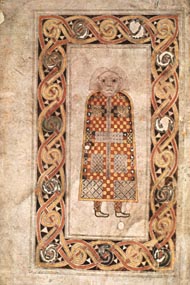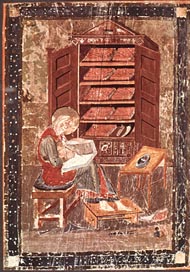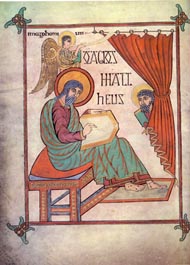Art
web | ARTH Home | ARTH
Courses | ARTH 109 | ARTH 109 Assignments | Forward | Back
| Contact
Arth 109
Insular / Hiberno-Saxon Art
Slide List 17

|

|
| Tara Brooch, 8th c. A.D. |
Purse lid from the Sutton Hoo Ship Burial,
gold with cloisonné enamel, 7th c. A.D. |
| |

|
| |
Gold Belt Buckle, from the Sutton Hoo Ship
Burial, 7th c. A.D. |

|

|
| The Ardgagh Chalice, 8th c. |
Detail of the Ardagh Chalice. |

|
 
|
| Symbol of St. Matthew from the Book of
Durrow, 2nd half of the 7th c. A.D. |
Shoulder Clasp from the Sutton Hoo Ship
Burial, gold with cloisonné enamel, 7th c. A.D. |
| |

|
| |
Carpet page from the Book of Durrow. |

|

|
| Prophet Ezra, from the Codex Amiatinus,
early 8th c. |
St. Matthew from the Lindisfarne Gospels,
late 7th c. |

|
  
|
| Incipit of Matthew I, 18 (Chi-Rho page),
Book of Kells, c. 760-820. (large format image) |
Details of the Chi-Rho page from the Book
of Kells. |
| |

|
| Eagle, symbol of St. John, Book of Kells. |
Sutton Hoo Purse Lid, 7th c. |
Additional Web Pages
For more on Hiberno Saxon art consult the webpages that I have
constructed for my Survey of Medieval Art. There are pages dedicated to the
Sutton Hoo Ship Burial , a general
discussion of Hiberno Saxon art,
and a separate page dedicated to an examination of the Chi-Rho
page from the Book of Kells.
List of Terms
Insular: pertaining to the British Isles (England, Scotland,
and Ireland). The term insular is used to encompass the cultures
of the various indigenous peoples (Celts, Angles, Saxons, etc.)
that inhabited the British Isles in the early middle ages.
The decorative vocabulary of Insular art can be broken down
into three distinct types: rectilinear, curvilinear,
and interlace. Within rectilinear ornament there are check,
step, and diagonal fret patterns. Curvilinear ornament comprises
circles, spirals, whirls, and trumpet patterns. Interlace is composed
of entangled strings or snakes. A variant of interlace is zoomorphic
interlace which is composed of entangled animal forms.
Cloisonné enamels: in making cloisonné
enamels the surface to be decorated is divided into compartments
with strips of metal (cloisons); the compartments are then filled
with enamel (glass in either powder or paste form) and the whole
piece is fired in a kiln.
Illuminated manuscripts: a hand-written book with decoration
and/ or illustrations. Note that the vast majority of these books
are written on parchment or animal skins.
Gospels: the story of the life of Christ as told in
the first four books of the New Testament. The authors (Matthew, Mark,
Luke, and John) are called the Evangelists.
Evangelist symbols: each of the four authors of the
Gospels have a symbol traditionally associated with them: Matthew-winged
man; Mark-lion; Luke-ox; John- eagle.
Evangelist portrait: a painting of an Evangelist introducing
his Gospel. This convention was derived from the tradition of
introducing Ancient manuscripts with author portraits.
Carpet page: a decorative page facing the opening of
each Gospel in an insular Gospel book.
Quotations
Bede, Ecclesiastical History, Book I, chapter 30:
The following are the instructions given by Pope Gregory the Great
to Abbot Melitus on the missionary activities in England.
"...when by God's help you reach our most reverend brother,
Bishop Augustine, we wish to inform him that we have been giving
careful thought to the affairs of the English, and have come to
the conclusion that the temples of the idols among that people
should on no account be destroyed. The idols are to be destroyed,
but the temples themselves are to be aspersed with holy water,
altars set up in them, and relics deposited there. For if these
temples are well-built, they must be purified from the worship
of demons and dedicated to the service of the true God. In this
way, we hope that the people, seeing that their temples are not
destroyed, may abandon their error and, flocking more readily
to their accustomed resorts, may come to know and adore the true
God."
John, I, 1: In the beginning was the Word, and the Word was
with God, and the Word was God
John I, 14: And the Word was made flesh, and dwelt among us,
(and we saw his glory, the glory as it were of the only begotten
of the Father,) full of grace and truth.
Giraldus Cambrensis, Topographia Hiberniae (1185):
"This book contains the harmony of the four Evangelists according
to St. Jerome, where for almost every page there are different
designs, distinguished by varied colors. Here you may see the
face of majesty, divinely drawn, here the mystic symbols of the
Evangelists, each with wings, now six, now four, now two; here
the Eagle, there the Calf, here the Man, and there the Lion, and
other forms almost infinite. Look at them superficially with the
ordinary casual glance, and you would think it an erasure, and
not tracery. Fine craftsmanship is all about you, but you might
not notice it. Look more keenly at it, and you will penetrate
to the very shrine of art. You will make out intricacies, so delicate
and subtle, so exact and compact, so full of knots and links,
with colors so fresh and vivid, that you might say that all this
was the work of an angel, and not of a man. For my part the oftener
I see the book, and the more carefully I study it, the more I
am lost in ever fresh amazement, and I see more and more wonders
in the book."
Claudius of Turin:
"I published three books [on Genesis] from the sayings of
the holy Fathers concerning the letter and the spirit... For the
word came into the world by Mary, clad in flesh; and seeing was
not understanding; all saw flesh; knowledge of the divinity was
given to a chosen few. So when the Word was shown to men through
the lawgiver and the prophets, it was not shown them without suitable
vesture. There it is covered by the veil of flesh, here of the
letter. The letter appears as flesh; but the spiritual sense within
is known as divinity. This what we find in studying Leviticus...
Blessed are the eyes which see divine spirit through the letter's
veil."
Questions for Review

|

|
| Purse Lid from Sutton Hoo, 7th c. |
Symbol of St. Matthew from the Book of
Durrow, 2nd half of the 7th c. |
Discuss the sources for the decoration of the Book of Durrow page
indicated by this comparison. What does this comparison indicate
about the way Christianity interacted with the cultural and artistic
traditions it met in the North.

|

|
| Ezra from the Codex Amiatinus, early 8th
c. |
St. Matthew, from the Lindisfarne Gospels,
late 7th c. |
Clearly both of these illustrations are based on the same model-
probably a sixth century Italian manuscript. Discuss how the artists
have reacted to the model in different ways. Note how in one case
the artist has tried to reproduce the original as accurately as
possible and in the other the artist has adapted the work to his
own stylistic idiom. Pay attention to aspects such as the different
approaches to space and color found in the two.
Art
web | ARTH
Home | ARTH Courses | ARTH 109 | ARTH
109 Assignments | Forward |
Back | Contact















